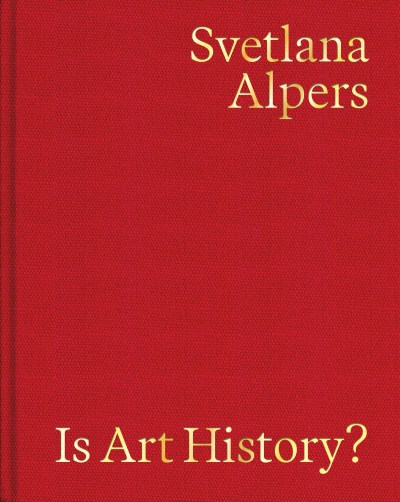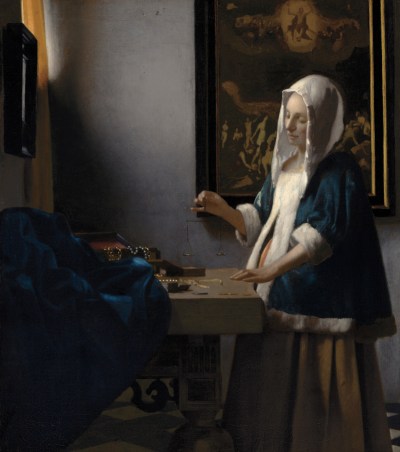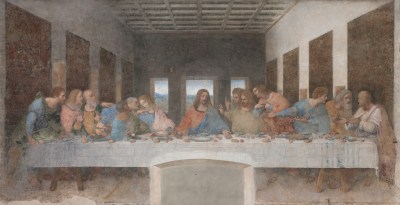
Courtesy Hunters Point Press, New York
I always think of a remark that the Italian artist Gino De Dominicis liked to repeat: all art exists in the present tense, and to think otherwise “would be like seeing a car from the 1920s coming and deciding to cross the street anyway, thinking that you couldn’t be run over because the car is from another era.” The witty title of Svetlana Alpers’s collection of a lifetime’s worth of essays, Is Art History?, suggests that for her too, the issue of art’s historicity and questions of how it impacts an observer in real time are recurrent concerns.
There is some relation between the history of art and its practice—and, don’t forget, the practice of its enjoyment—but that relation is hard to understand or articulate. Still, as Alpers writes, “the history internal to the making of art … is a Vasarian heritage,” about Giorgio Vasari, not only the first European art historian but an artist of significance. And yet Alpers can also say, though not in an absolute way, “I am interested in not so much how we see now, but discovering how they saw then.” She is sophisticated enough not to forget that “how they saw then” is a reconstruction in the now.
And then, as she writes most bluntly about Shirley Jaffe (though similar feelings arise recurrently throughout these essays), “her images are there not for words, but for seeing.” Words, including those of artists themselves—as prolix in their way as critics, curators, and historians—can serve vision but can also deflect from it. Alpers returns incessantly to the misfit between visual art and the words with which we attempt to channel and articulate the experience it offers, between (to continue De Dominicis’s metaphor) the impact of the collision and the cry of that occasion. A poignant detail from her essay on Jaffe’s colorful abstract paintings: “she turned to art because she was ashamed of her father’s accent: art for her was an alternative to language.” Jaffe’s paintings are, as Alpers writes, “word-free.” But my feeling is that they are filiated with those of Stuart Davis, and that it is specifically the words that Davis loved to incorporate into his painting, proto-Pop, of which Jaffe’s are free: words like champion, new, else/used to be/now. While Alpers explains and supports Jaffe’s assertion that her art has more in common with Picasso than Matisse, to whom she is often compared, I wish she had explored Jaffe’s more direct affinity with Davis, her most immediate American precursor.
ALPERS’S BOOK GATHERS a long lifetime’s product of a penetrating eye and mind. I assume it has been produced mainly for the use of (and as a challenge to) her fellow art historians. But I am here to tell you, as someone who is not a member of that guild, that her words offer pleasure and instruction to anyone who cares about art, and above all to make them wonder whether their ideas about it can be usefully reexamined. The texts range in date from an examination of Vasari’s ekphrases produced for E.H. Gombrich’s Harvard graduate seminar in 1959 and published the following year in the Journal of the Warburg and Courtauld Institutes to a brief contribution to the catalog for the Metropolitan Museum of Art’s 2023 exhibition on Diego Velázquez’s portrait of Juan de Pareja. A few of the pieces have not previously been published, while others were produced for relatively obscure or hard-to-find publications (like a series of book reviews for the magazine published by the Phi Beta Kappa Society).

Courtesy Hunters Point Press, New York
Alpers’s first Harvard seminar paper already evidences her originality of mind, and, in retrospect, her tenacity as well. She suggests that Vasari, the originator of European art history, can be read differently than had been the case. Why are his descriptions of paintings so consistent in form, whether they relate to Giotto (at the beginning of art’s development, as Vasari saw it) or Leonardo (near the culmination of that development with Michelangelo and Raphael)? Why don’t his ekphrases bear out his ideas about the path toward perfection?
Alpers’s solution is to say that Vasari distinguishes between technique and expression in art as between means and end. What’s to be expressed—the story and the emotions it arouses—remains constant. It is the technique, the means, that have been perfected, not the narrative emotion to be conveyed: “Giotto tells a story as well as Leonardo,” Alpers writes, “although the means have changed.” Thus, Vasari’s Lives of the Artists presents “imitation as the perfectible means and narration as the constant end of art.”
This idea has consequences that I cannot go into here. What’s impressive is the young historian’s willingness to shrewdly reread the most widely read art historical source against the grain of her elders’ understanding. And in distinguishing between narrative and representational aspects of art, Alpers is embarking on her examination of a problem that would preoccupy her for two decades: art historians’ inability to incorporate Dutch art into a historical model based on the Italian emphasis on narrative, and on the texts that supply art’s underlying narrative.
That line of inquiry, whose true culmination would be Alpers’s groundbreaking second book, The Art of Describing: Dutch Art in the Seventeenth Century (1983), is best represented here by her 1976 essay “Describe or Narrate? A Problem in Realistic Representation.” But it’s notable that among Dutch painters, Alpers is most interested in the three great exceptions who share the least in their countrymen’s faith in description: Bruegel, Rembrandt, and Vermeer. To the Dutch belief that art can offer a “certain grasp” on things, Alpers writes, “Vermeer responds with a deep uncertainty.” (That observation put me in mind of something a painter from the former West Germany told me some 20 years ago, when painters from the former East were becoming popular: “They paint out of what they know about painting. We paint out of what we don’t know.”)

Johannes Vermeer: Woman Holding a Balance, 1664.
Courtesy National Gallery of Arts, Washington, D.C.
ALPERS IS CONVINCING in her assertion that an art history based on the model she’d inherited from Gombrich, Erwin Panofsky, and the other émigrés who created mainstream art history fails to account for Dutch art. But if even Dutch painting turns out to be “an art without history … if the standard is set by the centuries of Italian or French art in the Louvre,” then what are the chances that the arts of other continents, other civilizations than those of Europe will ever be encompassed by a single history or a single discipline? Do the arts of the world become so many isolated silos?
Also: does art even have a history, or is it just that various narrowly defined artistic traditions have their separate histories, despite the fact that we see so many attempts at synthesis in the present? That’s a question Alpers hardly addresses. She has helped dissolve the hold of an old master narrative, but she doesn’t point us toward a new one.
I should not give the impression that Alpers’s interests are limited to the art of the Renaissance and Baroque eras, terms I use for convenience despite her reiterated suspicion of the notions of period style that go along with them. (An essay could be devoted to unraveling her reflections on the word style.) Alpers has a special interest in photography—in 2020 she published a book on Walker Evans, who is a recurrent reference point here—that is fulfilled in a beautiful essay on Judith Joy Ross. She is fascinated by the “marvelous and disturbing” work of the overlooked Abstract Expressionist Bradley Walker Tomlin, whose work, she explains, “hung in the New York penthouse apartment of an artist friend of my parents. It is the abstraction I remember, although there were many others hanging there.”

Leonardo da Vinci: The Last Supper, 1495–98.
Photo DEA/M. Ranzani via Getty
She also writes illuminatingly about contemporary artists as different as Tacita Dean, Rebecca Horn, and Alex Katz. Each seems to have been noticed for unrelated reasons, however; no history of the present seems in view here. She has something almost shockingly modest to say in response to a work by Ann Hamilton: “that it is simply surprising. There is no way of judging what its success might consist of artistically or what particular purchase it has on human experience.” I find the frankness of that impressive, precisely because, in her position, I would have felt duty bound to speculate on those things that she admits are imponderable.
Alpers insists that her concern “has always been with making, not with reception. I am not interested in how people take things, but how they make things.” And yet her writing is always imbued with the how and why and what of her own reception of artworks. That reception is what she calls reflexive. “My taste is for description,” she bluntly declares, but she doesn’t pretend to pure objectivity. Maybe it’s just that she is only interested in her own take, not in those of others. And that’s alright. Alpers proclaims herself “a contrary person,” and her contrariety, which she says she shared with her teacher Gombrich, shows its value in allowing her confidence in her own perspective and her ability to clarify her thoughts through writing. One’s own thoughts can seem terribly vague by comparison.
 Print
Print